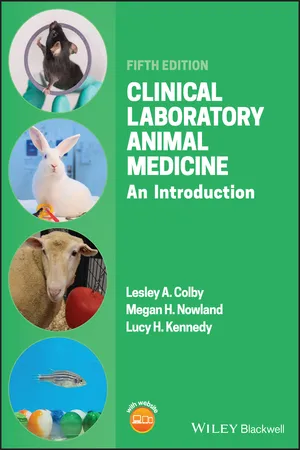
Clinical Laboratory Animal Medicine
An Introduction
- English
- ePUB (mobile friendly)
- Available on iOS & Android
About this book
The revised fifth edition of Clinical Laboratory Animal Medicine: An Introduction is an accessible guide to basic information for conducting animal research safely and responsibly. It includes a review of the unique anatomic and physiologic characteristics of laboratory animals, husbandry practices, and veterinary care of many animals frequently used in research, including rodents, rabbits, ferrets, zebrafish, nonhuman primates, and agricultural animals.
The updated fifth edition adds two new chapters on zebrafish and large animals, new information on transgenic models and genetic editing, and expanded coverage of environmental enrichment and pain management. The book presents helpful tip boxes, images, and review questions to aid in comprehension and learning, and a companion website provides editable review questions and answers, instructional PowerPoints, and additional images not found in the book. This important text:
• Provides a complete introduction to laboratory animal husbandry, diseases, and treatments
• Offers a user-friendly format with helpful content that highlights important concepts
• Contains new knowledge relating to technical methodologies, diseases, drug dosages, laws and regulations, and organizations
• Covers information on regulations, facilities, equipment, housing, and research variables as well as veterinary care
• Includes new chapters on zebrafish and cattle, sheep, goats, and pigs
Written for veterinary technicians, veterinary students, practicing veterinarians, and research scientists, the fifth edition of Clinical Laboratory Animal Medicine continues to offer an essential guide to the ethical treatment and anatomic and physiological characteristics of research animals.
Frequently asked questions
- Essential is ideal for learners and professionals who enjoy exploring a wide range of subjects. Access the Essential Library with 800,000+ trusted titles and best-sellers across business, personal growth, and the humanities. Includes unlimited reading time and Standard Read Aloud voice.
- Complete: Perfect for advanced learners and researchers needing full, unrestricted access. Unlock 1.4M+ books across hundreds of subjects, including academic and specialized titles. The Complete Plan also includes advanced features like Premium Read Aloud and Research Assistant.
Please note we cannot support devices running on iOS 13 and Android 7 or earlier. Learn more about using the app.
Information
1
Introduction to Laboratory Animal Medicine
Box 1.1
ANIMALS USED IN RESEARCH, TEACHING, AND TESTING
Biomedical Research
| Year* | Scientist(s) | Animal(s) Used | Contribution |
| 1901 | von Behring | Guinea pig | Development of diphtheria antiserum |
| 1904 | Pavlov | Dog | Animal responses to various stimuli |
| 1923 | Banting, Macleod | Dog, rabbit, fish | Discovery of insulin and mechanism of diabetes |
| 1924 | Einthoven | Dog | Mechanism of the electrocardiogram |
| 1945 | Fleming, Chain, Florey | Mouse | Discovery of penicillin and its curative effect in various infectious diseases |
| 1954 | Enders, Weller, Robbins | Monkey, mouse | Culture of poliovirus ... |
Table of contents
- Cover
- Table of Contents
- About the Authors
- Preface
- About the Companion Website
- 1 Introduction to Laboratory Animal Medicine
- 2 Regulations, Policies, and Principles Governing the Care and Use of Laboratory Animals
- 3 Facility Design, Housing, Equipment, and Management
- 4 Mice
- 5 Rats
- 6 Gerbils
- 7 Hamsters
- 8 Guinea Pigs
- 9 Chinchillas
- 10 Zebrafish
- 11 Rabbits
- 12 Ferrets
- 13 Primates
- 14 Cattle, Sheep, Goats, and Pigs
- 15 ResearchVariables, Biosecurity, and Colony Health Surveillance
- Appendix 1: Normal Values
- Appendix 2: Comparative Biologic and Reproductive Values by Species
- Answers to Review Questions
- Index
- End User License Agreement